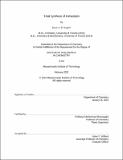Total Synthesis of Himastatin
Author(s)
D'Angelo, Kyan A.
DownloadThesis PDF (13.64Mb)
Advisor
Movassaghi, Mohammad
Terms of use
Metadata
Show full item recordAbstract
I. Total Synthesis of Himastatin via Bioinspired Oxidative Dimerization
The concise total synthesis of (–)-himastatin via a biomimetic final-stage dimerization is described. Our approach relies on expedient preparation of a macrocyclic depsipeptide monomer via hybrid solution/solid phase peptide synthesis, followed by a newly developed oxidative dimerization reaction to secure the C5–C5' biaryl linkage at the center of himastatin’s homodimeric structure. Application of the oxidative dimerization methodology enabled the preparation of dimeric C5–C5' cyclotryptophans, cyclotryptamines, and indolines via a radical-radical coupling pathway that was supported by mechanistic studies.
II. Synthesis and Biological Study of Himastatin Derivatives
The modularity and convergence of our hybrid solution/solid-phase approach to the synthesis of macrocyclic peptide monomers enabled general access to several himastatin derivatives and their comparative biological evaluation. Our findings indicate that the central C5–C5' biaryl linkage, depsipeptide linkage, and piperazic acid residue of himastatin are important for bioactivity, but that substitution of the leucine residue has negligible impact. The synthesis and biological evaluation of a series of stereochemical probes further reveal that the absolute stereochemistry of himastatin does not impact its bioactivity, consistent with primarily achiral interactions with its cellular target. Relying on our late-stage dimerization methodology for the union of complex macrocyclic peptide fragments, we also accessed a uniquely active heterodimeric fluorescent probe, TAMRA-himastatin. Confocal microscopy enabled direct observation of the antibiotic’s localization within Gram-positive bacteria, and provided evidence that himastatin targets the bacterial membrane as part of its mode of action.
Date issued
2022-02Department
Massachusetts Institute of Technology. Department of ChemistryPublisher
Massachusetts Institute of Technology